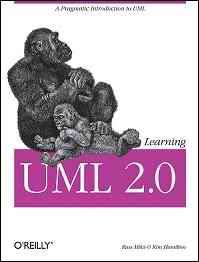
Author(s): Kim Hamilton, Russell Miles
Publisher: O'Reilly
Year: Apr 2006
ISBN: 0-596-00982-8
Language: English
File type: CHM
Pages: 286
Size (for download): 4.00 MB
The Unified Modeling Language (UML) is the standard modeling language for software and systems development. This statement alone is a pretty conclusive argument for making UML part of your software repertoire, however it leaves some questions unanswered. Why is UML unified? What can be modeled? How is UML a language? And, probably most importantly, why should you care?
Systems design on any reasonably large scale is difficult. Anything from a simple desktop application to a full multi-tier enterprise scale system can be made up of hundredsand potentially thousandsof software and hardware components. How do you (and your team) keep track of which components are needed, what their jobs are, and how they meet your customers' requirements? Furthermore, how do you share your design with your colleagues to ensure the pieces work together? There are just too many details that can be misinterpreted or forgotten when developing a complex system without some help. This is where modelingand of course UMLcomes in.
In systems design, you model for one important reason: to manage complexity. Modeling helps you see the forest for the trees, allowing you to focus on, capture, document, and communicate the important aspects of your system's design.
A model is an abstraction of the real thing. When you model a system, you abstract away any details that are irrelevant or potentially confusing. Your model is a simplification of the real system, so it allows the design and viability of a system to be understood, evaluated, and criticized quicker than if you had to dig through the actual system itself. Even better, with a formal modeling language, the language is abstract yet just as precise as a programming language. This precision allows a language to be machine-readable, so it can be interpreted, executed, and transformed between systems.
To effectively model a system, you need one very important thing: a language with which the model can be described. And here's where UML comes in.
TABLE OF CONTENT:
Chapter 01 - Introduction
Chapter 02 - Modeling Requirements: Use Cases
Chapter 03 - Modeling System Workflows: Activity Diagrams
Chapter 04 - Modeling a System's Logical Structure: Introducing Classes and Class Diagrams
Chapter 05 - Modeling a System's Logical Structure: Advanced Class Diagrams
Chapter 06 - Bringing Your Classes to Life: Object Diagrams
Chapter 07 - Modeling Ordered Interactions: Sequence Diagrams
Chapter 08 - Focusing on Interaction Links: Communication Diagrams
Chapter 09 - Focusing on Interaction Timing: Timing Diagrams
Chapter 10 - Completing the Interaction Picture: Interaction Overview Diagrams
Chapter 11 - Modeling a Class's Internal Structure: Composite Structures
Chapter 12 - Managing and Reusing Your System's Parts: Component Diagrams
Chapter 13 - Organizing Your Model: Packages
Chapter 14 - Modeling an Object's State: State Machine Diagrams
Chapter 15 - Modeling Your Deployed System: Deployment Diagrams
Appendix A - Object Constraint Language
Appendix B - Adapting UML: Profiles
Appendix C - A History of UML
DOWNLOAD
PASSWORD:ganelon
Password default : booktraining.net

No comments:
Post a Comment